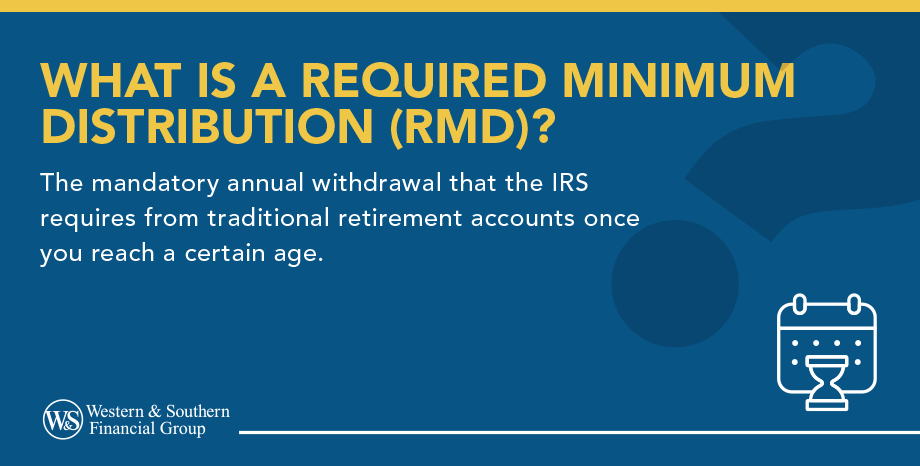Video Transcript
Did you know the IRS eventually requires you to start pulling money from your retirement accounts? These withdrawals are called Required Minimum Distributions, or RMDs. An RMD is the amount you must withdraw each year from tax-deferred accounts like traditional IRAs or 401(k)s once you reach a certain age. The IRS set these rules so people can't avoid taxes indefinitely by keeping money sheltered in retirement accounts.
Which accounts are affected? Traditional IRAs, SEP and simple IRAs, and employer plans like 401(k), 403(b), and 457(b) all require RMDs. Roth IRAs never require them during your lifetime, and starting in 2024, Roth 401(k)s also avoid RMDs, making them a popular vehicle for tax-efficient wealth transfer.
Your RMD is based on your account balance from December 31 of the prior year, divided by an I R S life expectancy factor. For example, if your IRA held 500 thousand dollars and your factor was 25.6, you'd need to withdraw about 19 thousand 500 that year.
Your first RMD is due by April 1 of the year after you reach the required age—currently 73 if you were born 1951–1959, and 75 if you were born in 1960 or later. If you delay, you'll owe two RMDs in the same year, which can bump you into a higher tax bracket.
RMDs are taxed as ordinary income. That extra income could increase the portion of your Social Security subject to taxes and raise your Medicare premiums. Skip an RMD and the penalty can be steep, 25 percent of the amount you should have withdrawn but may be reduced to 10 percent if corrected quickly.
Some retirees slip up by missing the first deadline, incorrectly combining accounts, or waiting until late in the year. These errors can trigger penalties and reduce your portfolio's growth potential. Some firms may offer automatic withdrawals to help you stay on track.
You can reduce the impact with Roth conversions, shifting funds into accounts without future RMDs. Another tool is a Qualified Charitable Distribution, which lets you donate up to $1,000 from an IRA directly to charity. This satisfies your RMD and lowers taxable income. Timing withdrawals strategically or consolidating IRA RMDs can also help.
RMDs affect what you leave behind. Most non-spouse heirs must empty inherited accounts within 10 years, often triggering higher taxes. Spouses have more options, like rolling the account into their own IRA. Trusts can also be named but must follow strict IRS rules.
RMDs are unavoidable, but with careful planning, they don't have to be painful. Understanding the rules helps you avoid penalties, reduce taxes, and better integrate withdrawals into your retirement and estate strategy. Visit WesternSouthern.com to learn more or talk with a tax advisor about your best approach.
Key Takeaways
- A Required Minimum Distribution is a mandatory annual withdrawal from a tax-deferred retirement account once you reach a specific age.
- RMDs are taxed as ordinary income, which could affect your Social Security benefits and Medicare premiums.
- Failure to take an RMD results in a 25% penalty, reduced to 10% if corrected promptly.
- Strategies like Roth conversions and Qualified Charitable Distributions can help reduce the tax impact of RMDs.
- Consulting with a tax advisor is highly recommended to create a personalized RMD strategy that aligns with your financial goals.
What Is a Required Minimum Distribution (RMD)?
A Required Minimum Distribution (RMD) is the mandatory annual withdrawal that the IRS requires from traditional retirement accounts once you reach a certain age.
The purpose of an RMD is to help ensure that retirees don’t keep money in tax-deferred retirement accounts indefinitely, avoiding taxation altogether.


Which Accounts Are Subject to RMDs?
Not all retirement accounts are subject to RMDs. Here’s a breakdown of which accounts require RMDs and which do not:
Accounts Requiring RMDs:
- Traditional IRA: Contributions to traditional IRAs are made pre-tax, meaning you must eventually pay taxes when withdrawing funds.
- SEP and SIMPLE IRAs: These types of IRAs for small business owners and self-employed individuals are also subject to RMD rules.
- 401(k), 403(b), and 457(b) Plans: Employer-sponsored retirement plans also require RMDs.
Accounts Not Requiring RMDs (During Lifetime):
- Roth IRAs: Roth IRAs do not require RMDs during the lifetime of the original account owner, making them a popular vehicle for tax-efficient wealth transfer.
- Roth 401(k): Historically, Roth 401(k)s were subject to RMDs. Starting in 2024, the SECURE Act 2.0 eliminated RMDs for Roth 401(k) accounts, aligning them with Roth IRAs.
How Are RMDs Calculated?
RMD calculations are based on your account balance at the end of the previous year and a life expectancy factor published by the IRS. The calculation is summarized as follows:
- Determine the Balance: Use your retirement account balance as of December 31 of the previous year.
- Identify the Life Expectancy Factor: This factor can be found in the IRS Uniform Lifetime Table. A separate table is used if your spouse is your sole beneficiary and is over 10 years younger than you.
- Calculate the RMD: Divide the account balance by the life expectancy factor. The result is your RMD for the year.
For example, if you have a traditional IRA worth $500,000 and your life expectancy factor is 25.6, your minimum distribution requirement for the year would be approximately $19,531.
When Must RMDs Be Taken?
- You must take your first RMD by April 1 of the year following the year you turn the required age.
Required Minimum Distribution Ages (Original Account Owners)
|
Birth Year |
Required Age |
|---|---|
|
Before July 1, 1949 |
70 1/2 |
|
July 1, 1949 thru 1950 |
72 |
|
1951 thru 1959 |
73 |
|
1960 and later |
75 |
- If you delay your first RMD until the following year, you must take two RMDs that same year. This delay could lead to higher taxable income and possibly push you into a higher tax bracket.
- Subsequent annual distributions must be taken by December 31 each year.
Mistakes to Avoid
RMDs can be complex, and there are several common mistakes that retirees make when managing them:
- Forgetting the First RMD: Missing your first RMD or misunderstanding the deadline can result in unnecessary penalties. Make sure to mark your calendar and plan accordingly.
- Not Aggregating Accounts Properly: If you have multiple IRAs, you can aggregate the RMDs, but you cannot combine RMDs from IRAs and 401(k)s. Understanding the rules is critical to avoiding penalties.
- Taking RMDs Too Late in the Year: If you wait until late in the year to take your RMD, market downturns could reduce your account balance, leading to smaller growth potential for the remainder of your funds.
Tax Implications of RMDs
RMDs are generally taxed as ordinary income, which means they are subject to federal income tax and, in some cases, state taxes as well. RMD income can impact other areas of your finances, such as:
- Social Security Taxation: Taking an RMD may increase your taxable income to the point where more of your Social Security benefits become subject to taxation.
- Medicare Premiums: When planning withdrawals, consider that higher income may raise Medicare Part B and Part D premiums, especially if your income is near a threshold level.
Tax Penalties for Failing to Take RMDs
The stiff penalty for failing to take a Required Minimum Distribution (RMD) is 25% of the amount you should have withdrawn.
For example, if your RMD was $10,000 and you didn't take it, the penalty would be $2,500.
Under the SECURE Act 2.0, the penalty, also known as an excise tax, can be reduced to 10% if the mistake is corrected promptly. Taking RMDs on time is important to avoid these costly penalties and potential tax complications.
Contacting a tax professional is recommended for any questions.
Strategies to Manage RMDs
Managing RMDs effectively is an integral part of retirement income planning. Here are some strategies to help minimize the tax impact and make the most of your retirement funds:
1. Roth Conversions
One effective way to reduce future RMDs is to convert a portion of your traditional IRA or 401(k) to a Roth IRA. Roth IRAs are not subject to RMDs, so you can let your investments grow tax-free without mandatory withdrawals.
Remember that a Roth conversion is a taxable event, so it’s best to consult a tax advisor to determine the optimal conversion timing and amount.
2. Qualified Charitable Distributions (QCDs)
Charitably inclined individuals can use a Qualified Charitable Distribution (QCD) to meet their RMD requirement.
A QCD allows you to transfer up to $100,000 annually from your IRA to a qualified charity. This charitable gift is excluded from your taxable income, potentially lowering your tax liability while supporting a cause you care about.
3. Withdrawal Timing
Consider timing your withdrawals carefully. For example, if you have significant medical expenses in a given year, you might want to take a larger distribution to take advantage of the medical expense deduction. Alternatively, if your income fluctuates, try to take your RMD in years when your tax bracket will be lower.
4. Aggregate RMDs for Multiple Accounts
If you have multiple IRAs, you can aggregate your RMDs, meaning you can take the total RMD amount from a single IRA instead of withdrawing from each account individually.
This can simplify the withdrawal process and give you more flexibility in managing your investments. Note, however, that RMDs from 401(k)s cannot be aggregated across different plans.
RMDs and Estate Planning
RMDs also play a role in estate planning. If you plan to leave your retirement accounts to heirs, consider how RMDs will impact their inheritance.
Since most non-spouse beneficiaries are now required to withdraw the entire account within 10 years, they may face significant tax burdens. Strategies like Roth conversions or charitable bequests can help reduce the tax impact on your heirs.
Another consideration is naming a trust as the beneficiary of your retirement account. While this can offer control over how the funds are distributed, the trust must meet specific IRS requirements to stretch distributions over the beneficiary's life.
If the trust does not meet these requirements, the entire balance may need to be distributed within five years, potentially resulting in a significant tax liability.
Special Considerations for Inherited Accounts
RMD rules also apply to inherited retirement accounts. If you inherit an IRA or 401(k), the distribution requirements depend on whether you are a spouse, a non-spouse beneficiary, or a trust.
Under the SECURE Act, most non-spouse beneficiaries must deplete the inherited account within a distribution period of 10 years from the original owner’s death, which can have significant tax implications.
Spousal beneficiaries have more flexibility. They can treat the inherited account as their own or roll it into their existing retirement account, allowing them to follow the regular RMD schedule.
RMD Planning Tips for Spouses
If you are married and your spouse is the beneficiary of your retirement account, you have some unique planning opportunities:
- Spousal Rollover: If you inherit your spouse’s IRA, you can roll it over into your own IRA and delay taking RMDs until you reach the appropriate age.
- Younger Spouse Advantage: If your spouse is more than 10 years younger than you and is the sole beneficiary, you can use the IRS Joint Life and Last Survivor Expectancy Table to calculate your RMDs. This often results in smaller RMDs, which can help reduce your taxable income.
Conclusion
RMDs are a critical part of retirement planning but don't have to be a burden. By understanding the minimum distribution rules and implementing effective strategies, you can minimize taxes and maximize your retirement income.
Consulting with a tax advisor is highly recommended to create a personalized RMD strategy that aligns with your financial goals.
Implement smart withdrawal strategies to help extend your retirement income. Start Your Free Plan
Frequently Asked Questions
How do I know what my required minimum distribution will be?
To determine your Required Minimum Distribution (RMD), you'll need your retirement account balance as of December 31st of the previous year and your life expectancy factor from the IRS Uniform Lifetime Calculation Table. Divide your account balance by the life expectancy factor to calculate your RMD for the year.
Remember that the age for taking RMDs has changed, so check the latest IRS guidelines to help ensure you're withdrawing the correct amount.
What is the 10-year rule for RMD?
The ten-year rule for Required Minimum Distributions (RMDs) applies to most non-spouse beneficiaries of inherited retirement accounts. Under this rule, regardless of age, beneficiaries must entirely withdraw the funds from the inherited account within 10 years of the original owner's death.
This rule eliminates the previous option for stretching distributions over a lifetime, potentially leading to higher taxes for beneficiaries depending on the timing and size of withdrawals.
At what age does RMD stop?
Unfortunately, RMDs don't stop at any age. Once you begin taking RMDs, you must continue withdrawing the required additional amount each year for the rest of your life. This applies even if you don't need the income, as the purpose is to help ensure eventual taxation of funds held in tax-deferred retirement accounts.
Is it better to take RMD monthly or annually?
Whether to take your RMD monthly or annually depends on your needs and preferences.
- Monthly: Provides a regular income stream, which can be helpful for budgeting and managing cash flow.
- Annual: Allows your investments more time to grow tax-deferred within the account.
Ultimately, the best approach is the one that best suits your circumstances and financial goals.
Do RMDs affect Social Security?
What is the 5-year rule for RMD?
The five-year rule applies to certain beneficiaries of inherited individual retirement accounts, primarily when the original account owner dies before they are required to take RMDs. It mandates that the entire inherited account be distributed within five years of the owner's death.
This rule is less common now due to the SECURE Act's 10-year rule, but it still applies in specific situations, such as for non-individual beneficiaries like an estate or a charity.
Sources and Footnotes
- Retirement topics - Required Minimum Distributions (RMDs) - Internal Revenue Service (IRS). https://www.irs.gov/retirement-plans/plan-participant-employee/retirement-topics-required-minimum-distributions-rmds
- Retirement plan and IRA required minimum distributions FAQs - Internal Revenue Service (IRS). https://www.irs.gov/retirement-plans/retirement-plan-and-ira-required-minimum-distributions-faqs
- RMD comparison chart (IRAs vs. defined contribution plans) - Internal Revenue Service (IRS). https://www.irs.gov/retirement-plans/rmd-comparison-chart-iras-vs-defined-contribution-plans
- IRA FAQs - Internal Revenue Service (IRS). https://www.irs.gov/retirement-plans/retirement-plans-faqs-regarding-iras
- SECURE ACT 2.0 – WHEN DOES THE RMD START? - National Society of Tax Professionals. https://www.nstp.org/article/secure-act-2-0-%E2%80%93-when-does-the-rmd-start
- Required Minimum Distribution (RMD) Rules for Original Owners of Retirement Accounts - Congressional Research Service. https://crsreports.congress.gov/product/pdf/IF/IF12750
- Guarantees are based on the claims-paying ability of Western and Southern Financial Group. Product and feature availability may vary by state.





























